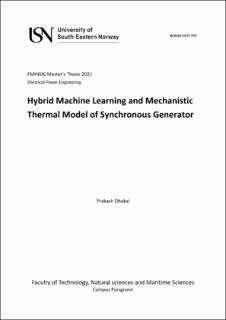| dc.description.abstract | Overheating of synchronous generators may result in shortened generator lifespan, thus strict constraints are imposed on their operation. A dynamic model of the generator temperature may leave good monitoring of the generator condition, and also more flexible operation. Within the past, the mix of a thermal model of an air-cooled generator with better control has been considered to assist ride-through problems: By using a model-based online monitoring , the temperature development in certain locations within the synchronous generator were kept in restraint. Additionally, exploiting the generator’s full thermal capacity led to improved performance [1]. Further work has considered various improved thermal generator models, together with model fitting and state estimation [2]. Now also, the studies thus far have used normal, counter-current heat exchanger models with constant Stanton numbers, which authorize for an analytic, explicit heat exchanger models description. In [2], a heat exchanger model with temperature-dependent heat capacities was considered. The result's a two-point boundary value problem that's several thousand-fold slower to resolve than with a relentless Stanton number. To hurry up the solution, a nonlinear regression model was trained off-line to suit the solution of the boundary value problem. However, what is missing in [3] is that the possibility to think about heat exchangers with varying heat transfer coefficients. The thermal model of an air-cooled synchronous generator created in [4] and enlarged in [3] with a more realistic temperature-dependent condition was continued during this thesis, with variable heat transfer coefficients, to lower the time it takes a heat exchanger model to resolve a temperature-dependent problem. A hybrid model was created with estimated parameters from a data-driven model for a spread of scenarios, and also the performance was compared to the numeric solution, which was around 220 times quicker. | |
